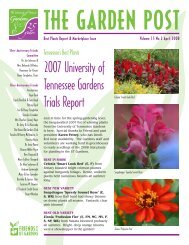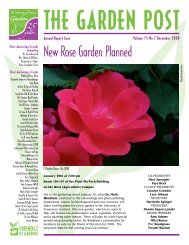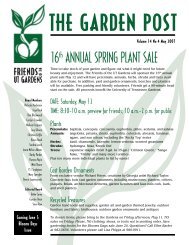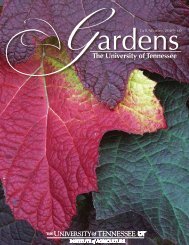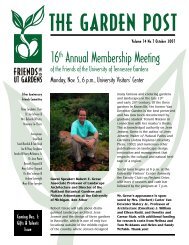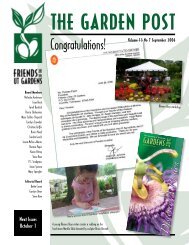Fall|Winter 2012-13 - UT Gardens - The University of Tennessee
Fall|Winter 2012-13 - UT Gardens - The University of Tennessee
Fall|Winter 2012-13 - UT Gardens - The University of Tennessee
Create successful ePaper yourself
Turn your PDF publications into a flip-book with our unique Google optimized e-Paper software.
Book Review<br />
By Joan Worley, Blount County Master Gardener<br />
When it comes to a four-season climate with a modicum <strong>of</strong> winter snow, blue<br />
mountains on the horizon, strangers who smile and say hello, and more<br />
than a few remnants <strong>of</strong> the way things used to be, East <strong>Tennessee</strong> is hard<br />
to beat. It’s no secret. Many <strong>of</strong> us moved here from somewhere else, and<br />
we keep coming. Once here, gardeners from cooler climates have to get used to the red<br />
clay, heat and humidity that makes outdoor life so “interesting.”<br />
Garden books reviewed and extolled in national media are lavishly illustrated, well<br />
written and useless. Magazine articles, too. Not always, but too <strong>of</strong>ten they are by people<br />
who wear sweaters year-round, from places where the cornbread tastes like cake.<br />
Jim Wilson’s “Bulletpro<strong>of</strong> Flowers for the South” (Dallas: Taylor Publishing Company,<br />
1999) is my go-to book for ideas and how-to’s that work right here in River City, and it’s<br />
a good one to recommend to newcomers. Despite its publication date, it is remarkably<br />
current and readily available in local libraries and for purchase online. Wilson (1925-<br />
2010) is remembered fondly by “Victory Garden”-ers as the longtime Southern host <strong>of</strong><br />
the television show. On screen, he was an altogether likeable fellow: knowledgeable,<br />
forthright, cheerful, and always happy to be talking gardens and gardening. Off screen,<br />
Jim was a prolific garden writer, and among many other accomplishments, he ran the<br />
All-American Selections program in the 70s.<br />
Other books by Jim Wilson (aka<br />
James W. and James Wesley<br />
Wilson, depending on the<br />
catalog or bookseller) include<br />
“Homegrown Vegetables, Fruits<br />
& Herbs: A Bountiful Healthful<br />
Garden for Lean Times” (2009);<br />
“<strong>The</strong> Carolinas: Gardener’s<br />
Guide” (2005), with Toby Best;<br />
“Container Gardening” (2000);<br />
“Landscaping With Native Trees”<br />
(1995) with Guy Sternberg;<br />
“Landscaping with Herbs” (1994);<br />
“Landscaping With Wildflowers”<br />
(1992); and “Masters <strong>of</strong> the<br />
Victory Garden” (1990). He wrote<br />
14 in all.<br />
<strong>The</strong> heart <strong>of</strong> “Bulletpro<strong>of</strong> Flowers,” the actual middle <strong>of</strong> the book, is 75 pages <strong>of</strong><br />
“Favorite Flowers for Southern Summers,” arranged A-Z by common name, with first,<br />
information in brief (heat and hardiness zones, mature height, light requirements),<br />
commentary on each <strong>of</strong> the 100 flowers selected for the book, and at least one excellent<br />
color photograph per plant, most by the author. “Flowers” is used in a broad sense, not<br />
necessarily for blossoms to put in a vase; the flower may be an herb or a fern, annual<br />
or perennial, woody shrub or tender vine. Be prepared for surprising omissions in the<br />
list — the fore matter explains Jim’s criteria for “a treasure trove <strong>of</strong> flowers … that will<br />
bloom through most or all <strong>of</strong> the summer months, either in ground beds or containers,<br />
or both.”<br />
Although the A to Z list will be well-thumbed, what comes before and after is equally<br />
valuable: the six-page introduction is a must read, as it sets out some basic definitions —<br />
i.e., which eight states and parts <strong>of</strong> six others constitute Jim’s South. Whoa! How can any<br />
one book cover such a large and diverse geographical area Here’s how: I’m guessing,<br />
but I did not find extremes at either end <strong>of</strong> the scale; plants that can’t take prolonged cold<br />
(Oleander, Fatsia) and those that require or prefer it (Hostas, Helleborus) were zoned out.<br />
Plants that thrive in several zones (6-11) were selected. Bulletpro<strong>of</strong>, indeed. Also, Jim’s<br />
notes on hardiness and heat zones are a help: “... annual in zone 8 and further north,”<br />
and “Perennial in all southern zones, but needs a pinestraw mulch in zone 6.” If there are<br />
heat or hardiness variations among cultivars, he is even more specific.<br />
<strong>The</strong> first three chapters, before the A to Z, are full <strong>of</strong> information I didn’t know I needed<br />
until I read it. (I only thought I knew how to water.) <strong>The</strong> author <strong>of</strong>fers a lifetime <strong>of</strong><br />
gardening wisdom and experience in an easy, conversational style. His occasional<br />
historical asides on earlier gardening practices have a charm all their own, and the<br />
information is solid. Reading the chapter, “What Gardeners Can Do to Minimize the<br />
Impact <strong>of</strong> Heat and Humidity,” I found myself “ohing” a lot, as in “Oh! I didn’t know<br />
that,” and “Oh, what a good idea!”<br />
<strong>The</strong> final chapter, “Flowers and Foliage Plants Recommended by Southern Experts,” has<br />
lists from some 20 retail nurseries, botanical gardens, individuals, and university test<br />
gardens throughout the South, among them one from Dr. Susan Hamilton, reporting<br />
from the <strong>University</strong> <strong>of</strong> <strong>Tennessee</strong> test gardens. She said that summer that year was hot.<br />
10 <strong>UT</strong> <strong>Gardens</strong>



